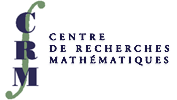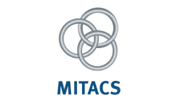 |
|
||||
Org: André Boivin and Tatyana Foth (Western)
[PDF]
- NADYA ASKARIPOUR, University of Western Ontario, London, ON
On holomorphic k-differentials on open Riemann surfaces [PDF] -
Let S be a hyperbolic Riemann surface, we study the spaces of integrable, square integrable and bounded holomorphic k-differentials on S-L, where L is a closed subset of S, and k > 1 is an integer. The main result will provide a description of the kernel of the Poincaré series map.
This is joint work with T. Foth.
- LINE BARIBEAU, Université Laval, Québec
Hyperbolic divided differences and the Nevanlinna-Pick problem [PDF] -
Starting from the notion of the complex pseudo-hyperbolic distance and the hyperbolic difference quotient introduced by A. F. Beardon and D. Minda, we define hyperbolic divided differences for unimodularly bounded holomorphic functions in the unit disc. In particular, we show that they operate on Blaschke products in the same way as the ordinary divided differences act on polynomials. Using these concepts we investigate the classical interpolation problem of Pick and Nevanlinna and reformulate the Nevanlinna-Schur algorithm in terms of hyperbolic divided differences. This leads to a scheme that (formally) coincides with Newton's algorithm for polynomial interpolation.
This is joint work with P. Rivard and E. Wegert.
- DAVID BARRETT, University of Michigan, Ann Arbor, Michigan 48109, USA
Dual Hardy spaces on dual hypersurfaces in CPn [PDF] -
If g is a simple closed smooth curve in the complex plane C then it is not hard to show that the norm (on L2) of the associated (inner or outer) Cauchy transform for g is equal to the reciprocal of
where H+ and H- are the inner and outer Hardy spaces associated to g (with p=2); thus the norm of the Cauchy transform measures the efficiency of the pairing between H+ and H-. Projective geometry plays a role in this result in that everything in sight transforms well under linear fractional transformations.
inf
f Î H+, ||f||=1
sup
g Î H-, ||h|| = 1ê
êó
õ
gfg dz ê
êThis talk will show how the "dual complement" construction in higher-dimensional complex projective space CPn allows this result to be generalized to the case of (certain) higher-dimensional real hypersurfaces.
- ILIA BINDER, University of Toronto
Quasiconformal images of McMullen carpets and self-affine percolation clusters [PDF] -
We establish lower bounds on the dimension of a quasiconformal images of the self-affine McMullen carpets. We also compute the conformal dimension of . We also show that the clusters of a self-affine version of fractal percolation are a.s. minimal, i.e., the dimension of any quasiconformal image of the cluster can not be less then the dimension of the set itself.
This is a joint work with Hrant Hakobyan (Toronto).
- THOMAS BLOOM, University of Toronto, 40 St. George St., Toronto
Voiculescu's Entropy and potential Theory [PDF] -
That the (negative of) the logarithmic energy of a planar measure is the triple limit of volumes originated in the work of Voiculescu in the 1990s. Subsequently, this result was put in the context of large deviations by Ben Arous and A. Guionnet. We will give a new proof of this result and discuss the several variable case.
- SERBAN COSTEA, McMaster University, 1280 Main St. West, Hamilton, ON L8S 4K1
Corona Theorems for Multiplier Algebras on Bn [PDF] -
Carleson's Corona Theorem from the 1960's has served as a major motivation for many results in complex function theory, operator theory and harmonic analysis. In a simple form, the result states that for N ³ 2 bounded analytic functions, f1,...,fN on the unit disc with no common zeros in a quantitative sense, it is possible to find N other bounded analytic functions, g1,...,gN such that f1 g1 + ¼+ fN gN = 1. Moreover, the functions g1,...,gN can be chosen with some norm control. In this talk we will discuss some new generalizations of this result to certain function spaces on the unit ball in several complex variables. In particular, we will highlight the Corona Theorem for the Drury-Arveson space and for the space of BMO analytic functions.
This is joint work with Eric T. Sawyer and Brett D. Wick.
- PETER DUREN, Department of Mathematics, University of Michigan, Ann Arbor, MI 48109-1043, USA
Schwarzian derivatives of convex mappings [PDF] -
For a function f analytic and locally univalent in the unit disk D, the Schwarzian derivative is Sf = (f"/f¢)¢- [ 1/2] (f"/f¢)2 and the Schwarzian norm is ||Sf|| = supz Î D (1-|z|2)2 |Sf(z)|. In 1949, Nehari proved that ||Sf|| £ 2 implies that f is univalent in D. In 1976 he showed conversely that ||Sf|| £ 2 if f maps the disk univalently onto a convex region. We give a simple proof based only on the Schwarz lemma.
Nehari also claimed to show that ||Sf|| < 2 for bounded convex mappings. We verify this by proving more generally that the image of a convex mapping with ||Sf|| = 2 cannot be a quasidisk.
Joint work with Martin Chuaqui and Brad Osgood.
- BRUCE GILLIGAN, University of Regina, Regina, SK S4S 0A2
Compact CR-solvmanifolds as Kaehler obstructions [PDF] -
Let G be a connected, simply connected, complex, solvable Lie group, G0 a closed subgroup of G and G a discrete subgroup of G0 such that G0/G is compact. We characterize when G0/G admits a CR-embedding into a Kähler manifold in terms of conditions on the Lie algebra \mathfrak g0 of G0. For G nilpotent it was known that this is equivalent to the existence of a Lie algebra splitting g0 = a0 Åm, where the maximal complex ideal m : = g0 Çi g0 is abelian and a0 Çi a0 = 0. For G solvable things are more complicated. We use the fibration G/G® G/N·G and its restriction to G0/G to analyze the situation, where N denotes the nilradical of G. The essential condition is on the adjoint representation of g0 on m; it must have purely imaginary spectrum and be diagonalizable. Examples will be presented that illustrate the theory.
This is joint work with Prof. Karl Oeljeklaus, l'Université de Provence, Marseille, France.
- IAN GRAHAM, University of Toronto
The structure of Loewner chains in several variables which are normalized at 0 in terms of a positive linear operator [PDF] -
In joint work with H. Hamada, G. Kohr, and M. Kohr in 2008, it was shown that much of the existence theory for solutions of the Loewner differential equation in several variables could be generalized to univalent subordination chains with a normalization at 0 given in terms of a positive linear operator with certain restrictions on the spectrum (instead of the identity operator). We will recall some of the features of this work and discuss a structure theorem for the solutions of this equation which was recently obtained in joint work with P. Duren, H. Hamada, and G. Kohr.
- ALEXANDER IZZO, Bowling Green State University, Bowling Green, OH
Function Algebras Invariant under Group Actions [PDF] -
We will answer a question raised by Ronald Douglas in connection with his work on a conjecture in operator theory due to William Arveson. Let S denote the unit sphere in C n. If A is a function algebra on S that contains the ball algebra A(S) and whose maximal ideal space is S, and if A is invariant under the action of the n-torus on S, does it follow that A = C(S)? When n=1, Wermer's maximality theorem gives immediately that the answer is yes. Surprisingly, in higher dimensions the answer depends on the dimension. The proof is related to a peak point theorem of John Anderson and the speaker and counterexamples to the peak point conjecture due to Richard Basener and the speaker.
We will also present a conjecture of a more general nature concerning function algebras that are invariant under a transitive group action, and we will prove the conjecture under a mild additional hypothesis.
- DAMIR KINZEBULATOV, University of Toronto
Holomorphic almost periodic functions on coverings of complex manifolds [PDF] -
In the talk we establish a natural `link' between two classical theories: Bohr's holomorphic almost periodic functions in tube domains in Cn and von Neumann's almost periodic functions on topological groups-namely, we introduce and study holomorphic almost periodic functions on coverings of complex manifolds.
In particular, we discuss the following related results: a variant of `holomorphic Peter-Weyl theorem', extension theorems from holomorphic almost periodic submanifolds, some results on structure of the maximal ideal spaces of certain subalgebras of bounded holomorphic almost-periodic functions and geometry of almost periodic analytic sets.
This is joint work with Alexander Brudnyi.
- LOREDANA LANZANI, University of Arkansas, Fayetteville, AR 72701
Representations for holomorphic functions on domains with reduced boundary regularity [PDF] -
I will discuss some classical representations for Hardy spaces of holomorphic functions on domains in several complex variables, in the non-classical context of lack of boundary regularity (the ambient domain is non-smooth).
- LINA LEE, University of Michigan
Supnorm estimate for the [`(¶)]-equation on weakly convex domains in C2 [PDF] -
We estimate the supnorm of the solution for [`(¶)]-equation on some examples of weakly convex domains in C2, which are flat near one boundary point. We use Henkin's integral formula to find the solution and show that there's a critical degree of flatness that guarantees the supnorm estimate.
- JAVAD MASHREGHI, Laval
On the derivative of inner functions [PDF] -
According to the canonical factorization theorem, an inner functions decomposes as f = BS, where B is a Blaschke product formed with zeros (zn)n ³ 1 and S is a singular inner function generated by a positive singular measure s. The relation between various integral means of f¢ on one hand, and (zn)n ³ 1 and s on the other hand, has attracted the attention of many mathematicians at least since th 1960s. In this talk, we will discuss the rich history of this subject and, if time permits, we mention some recent developments.
- ALIP MOHAMMED, York University
Poisson Equation with the Third Boundary Condition [PDF] -
The inhomogeneous Robin/third boundary condition with general coefficient for the Poisson equation on the unit disc is studied in terms of holomorphic functions using Fourier analysis. It is shown that against the usual expectations this problem cannot have a unique solution unless the coefficient of the first order term in the boundary condition is a constant. For the case of general coefficient, it is actually a problem with essential singularity in the domain, but still well-posed under proper assumptions and the unique solution is given explicitly.
- ERIC SCHIPPERS, University of Manitoba, Winnipeg, MB
The Teichmueller space of an annulus and the semigroup of rigged annuli [PDF] -
The Lie algebra of the group of diffeomorphisms of the circle Diff(S1) is the set of smooth vector fields tangent to the circle. Although this Lie algebra has a complexification, by a theorem of Lempert, there is no group whose Lie algebra is this complexification. As part of his sketch of a mathematical formulation of conformal field theory, G. Segal introduced a semigroup of annuli with boundary parametrizations or "riggings", which in some sense is the complexification of Diff(S1).
By enlarging the class of boundary parameterizations, we show that this semigroup is in fact a discrete quotient of the Teichmüller space of an annulus. In particular this introduces a complex structure on the semigroup, in which multiplication is holomorphic. If time allows we will explore some further connections with geometric function theory.
Joint work with David Radnell.
- VASILISA SHRAMCHENKO, Université de Sherbrooke, 2500 boul. de l'Université, Sherbrooke
Fuchsian Riemann-Hilbert problem associated to Frobenius manifolds [PDF] -
There are two (dual to each other) Riemann-Hilbert problems naturally associated to every semisimple Frobenius manifold. In the case of Frobenius structures on Hurwitz spaces, the corresponding Riemann-Hilbert problems turn out to be solvable in terms of meromorphic bidifferentials defined on the underlying Riemann surface.
In this talk, I will present solutions to one of these Riemann-Hilbert problems (the one with Fuchsian singularities) and discuss their properties and monodromy.





